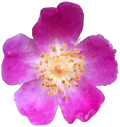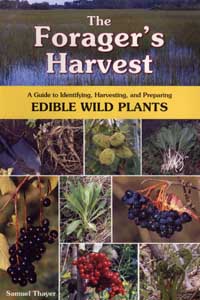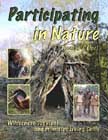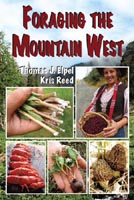Highbush Cranberry
A Loser In the Name Game
By Sam Thayer
From The Forager. Volume 1, Issue 4. Fall-Winter 2001
There has been a decades-long uninformed debate over Highbush cranberries. Some people insist that the fruit is bitter and unpalatable, even when cooked into jelly or sauce. Others say that the fruit is very tart but tasty, like the true cranberry. (The Highbush cranberry is not closely related to the true cranberry Vaccinium macrocarpon.) This debate results from the fact that the common name "highbush cranberry" actually refers to three different species, each of which has different eating qualities. That's why botanists use scientific names. It doesn't help, however, that some botanists don't differentiate between two of the three species. I even know of a large mail-order tree nursery that sells one species labeled with the name of the other!
The first species that I wish to discuss is Viburnum opulus, the European highbush cranberry or guelder rose. I prefer to call this plant "bad highbush cranberry" because that name is instructive to the forager. The fruit of this species is so bitter that I think it is stretching the truth to call it edible. Ingestible, perhaps, as medicine -- but not edible. On the other hand, the American (good) highbush cranberry bears fruit that are very tart but perfectly delicious when prepared in a reasonable manner. Indeed, they taste very similar to our familiar bog cranberry. The two shrubs are remarkably difficult, but not impossible, to distinguish by sight - but one should have little trouble telling them apart by taste (except for hybrids, which probably occur, although I have never encountered one). The third species, V. edule, is also called squashberry. It is reported to taste even better than V. trilobum, but I have never had the pleasure of confirming this.
The European highbush cranberry is most common in the eastern United States and southeastern Canada, where it persists as an escaped ornamental shrub in towns and around farms. The American highbush cranberry is native to the northern United States and the southern third or so of Canada, where it is found growing along streams and ponds, in river bottom forests, in hardwood swamps, and occasionally upland. They do NOT need wet soil, however, and generally survive wherever they are planted. The last species, squashberry, is found in boreal forests of Canada, Alaska, and the far northern states. All three species are intolerant of shade. Since the American highbush cranberry V. trilobum is abundant where I live in northern Wisconsin, the rest of this discussion will apply primarily to that species.
The bushes grow to about fifteen feet in height and have distinctly maple-shaped, opposite leaves. They flower in early to mid June, bearing clusters (umbels) of white flowers. (These flower clusters are quite unusual in that they contain real flowers surrounded by larger, showier "fake flowers," which are infertile.) The bark of highbush cranberry is light, almost white, and rather smooth. This bark (as well as other parts of the plant) contains a chemical known as viburnin that is effective at relieving menstrual cramps, for which purpose it has been used since antiquity. This accounts for another common name, cramp-bark.
The small fruits, about a half-inch long, begin to turn from green to red in late August. As soon as they do so, they are ready to eat, though they will still be hard and crunchy. At this stage, they taste almost exactly like true cranberries, except that they contain a single large, flat, oval seed, which is somewhat bitter if chewed. To make juice from these still-hard cranberries, freeze them and then thaw them. (This should make them soft and juicy.) Then crush them. I do this by placing about two gallons of the berries in a five-gallon bucket, adding about a quart of water, and crushing them with my "stomper" (the same six-foot-long, heavy, flat-ended stave of wood that I use for cracking acorns and fending off stray rhinos.) After thoroughly mashing the berries, I press them in a colander to separate the juicy pulp from the seeds and skins. I do not boil the whole fruit, for this seems to release some of the bitterness of the seeds into the product.
The highbush cranberry pulp can be used to make jam, cranberry sauce, or cranberry-applesauce. It can also be drunk as a thick, pulpy juice. Many people prefer to strain the pulp through a cheesecloth or jelly bag to separate the solids (which can still be used for jam or cranberry sauce) and achieve a "cleaner" looking final product. The strained juice can then be used to make a wonderful jelly. It can also be added to juice mixes, or diluted (and possibly sweetened, as most prefer) and drunk alone. It can even be drunk at full-strength, unadulterated, in little tiny sips - which is how I prefer it.
If you do not own a cheesecloth or jelly bag, the solids can be separated from the juice in another way. Just let the pulp sit in a pitcher in the refrigerator for a day or two. The bits of fruit will settle to the bottom quarter or so of the container, with clean juice remaining at the top. Just pour off the juice carefully to separate it from the sludge. I store my highbush cranberry juice by canning it in a water bath. Some people with freezers freeze theirs, if they have room. Fortunately, due to some natural antibiotic qualities, the juice also lasts quite a long time in the refrigerator.
I prefer to harvest highbush cranberries when they have turned red but are still hard, but I'm often too late for this, since they ripen at the busiest time of the year for the forager. Although the fruit can always be harvested until early November, and sometimes through the winter, it is important to remember that the sooner after ripening they are harvested, the better their flavor will be. Frost does NOT improve their quality, as some people contend. I try to pick all of my highbush cranberries before early October when the leaves fall, for soon after this they begin to shrink with evaporation. Often by the middle of November the birds will have consumed all of the fruit. ("The birds ignore "bad" highbush cranberries, however, until they are desperate.)
One endearing quality of highbush cranberry is that it is generally easy to pick in large quantities. The fruit is conveniently arranged in clusters at the ends of the limbs, and these thornless branches are limber - as if they are asking you to remove the cumbersome burden of so much scarlet fruit. I have often gathered more than a gallon from a single bush, and rarely does it take more than twenty minutes to do so. Highbush cranberry is also the most consistently productive fruit in my area, and has one of the longest seasons of availability - so I've never had to endure an autumn without any.
If you like cranberries, you will like our native highbush cranberry. If you taste some that you find disgusting, understand that they are almost certainly its exotic look-alike; don't judge all highbush cranberries accordingly. It would be your loss, for the good ones are mighty good.
Be sure to a look at Sam Thayer's book:
The Forager's Harvest: A Guide to Identifying, Harvesting, and Preparing Edible Wild Plants
Also be sure to see Botany in a Day: The Patterns Method of Plant Identification










